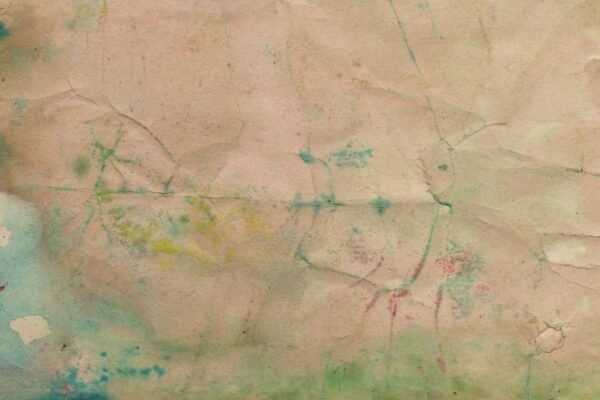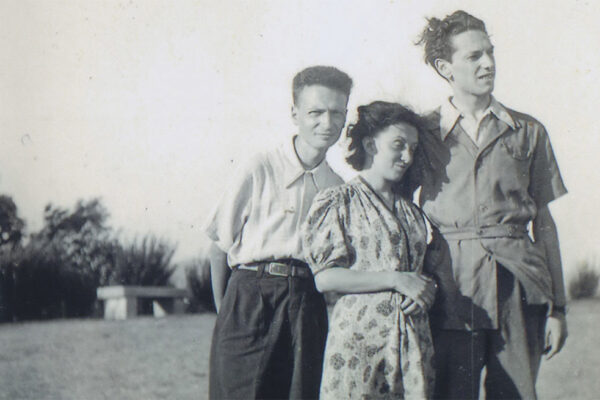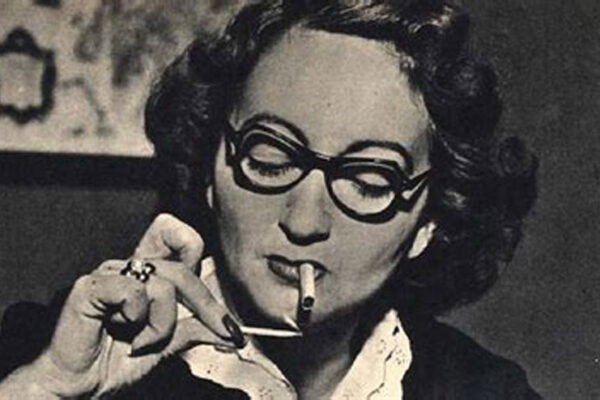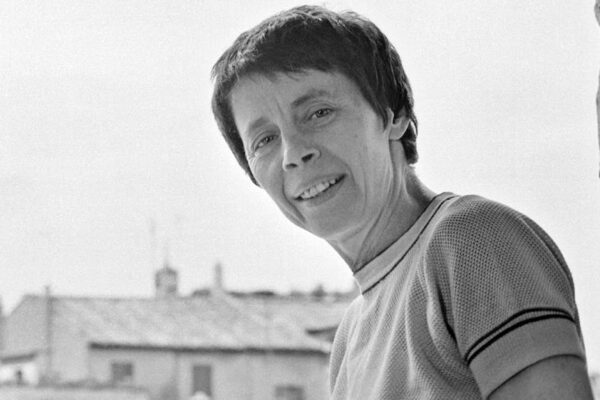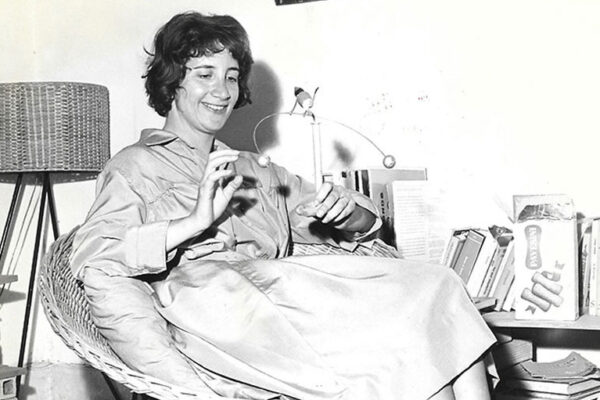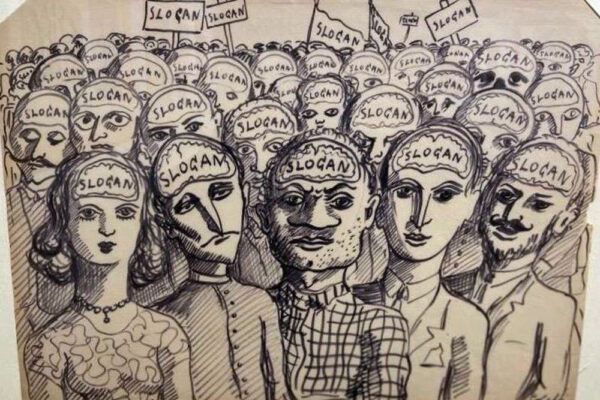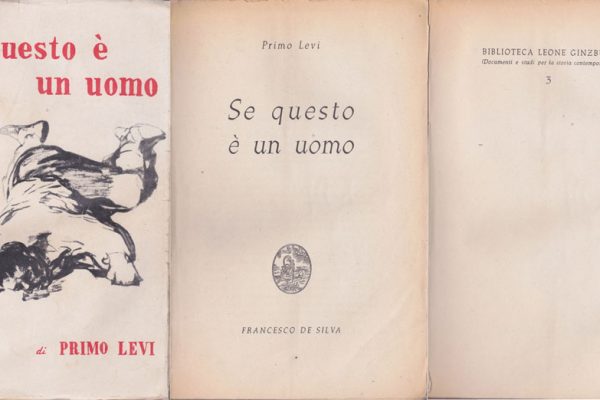How Franz Werfel’s novel about the Armenian Genocide inspired the Warsaw Ghetto fighters and the Zionist resistance
A crowded hotel lobby in Breslau in late 1932. People waited there to see “the man of the hour,” Adolf Hitler. Hitler was touring Germany in his final bid for power. One of the spectators in the Breslau Hotel lobby was Franz Werfel. Werfel was disconcerted by seeing Hitler in person. When asked by his wife what his first personal impression of the Nazi leader had been, Werfel had reluctantly admitted, “Unfortunately, not so bad.” And this only made his current project all the more urgent: to warn Germany against Hitler.
Werfel was a German writer, born in Prague to a Jewish family. His most successful novel, The Forty Days of Musa Dagh, is a literary monument to the Armenians and their fate in the Armenian Genocide that took place during World War I. It follows the fate of Armenian communities in southern Turkey who fled to the high mountains around Moses Mountain (Musa Dagh), from where they fought the advancing Ottoman army. They knew the fate that awaited them in the Ottoman Empire: genocide. They held out for 40 days (in Werfel’s version; in reality it was 53 days) and were eventually rescued by French and British warships, just as ammunition and food supplies were running out, and were then evacuated to Port Said, Egypt. This lengthy novel, often published in two volumes, is a story of murder, desolation, and suffering, but it is also one of hope.
Looking back it almost seems far-fetched to point out the intricate connection of this novel with the Third Reich and the coming Holocaust. This is partly also because until now we knew too little about the interconnectedness of Jewish and Armenian history within German history—and about the role of the Armenian Genocide in the pre-history of the Shoah. A focus on the singular horrors of the Shoah, combined with Turkish denialism, has led to an impression—transported by the numerous histories of the times—of an immense distance in space and time between the two genocides. But for people like Werfel it did not feel distant; it felt all too close. In late 1932, he was rushing to finish his Armenian novel, which he intended as a grand warning to Germany of what Hitler would accomplish.
Werfel said about the book that the Armenians were his “stand-in Jews.” He assumed that his readers would understand the parallels between the Young Turk dictatorship and the Nazi dictatorship, and between the Turks’ anti-Armenianism and the Nazis’ anti-Semitism—and so would see the genocide of the Armenians as something that could be in store for German Jews. While it is a common assumption that Germans did not and could not know in 1932/1933 that Hitler’s rise to power could mean genocide, Werfel (and other of his German contemporaries) felt quite differently.
Werfel started writing in 1932. In the same year, he gave his first readings from his unfinished manuscript—which is why he was in Breslau when he saw Hitler in the lobby. Hitler was there to rally Germany behind him and his ideas for the country, while Werfel was there to read from his book to warn Germany against Hitler and his ideas. That evening, he had read the chapter of his book in which, in the midst of the genocide, the German champion of the Armenians, the pastor Johannes Lepsius, meets Enver Pasha, the Ottoman minister of war, to intervene on behalf of the Armenians and to stop the genocide in progress.
Werfel was writing against Hitler, and against the clock; and he lost both contests. Hitler was appointed chancellor in early 1933, merely a few weeks after the two men crossed paths in Breslau. In May 1933, overeager Nazis (students, Nazi storm troopers, librarians, and others) piled up books of “un-German” authors and set them ablaze to celebrate the victory of a “new spirit.” This signaled many things, one among them, of course, that the ideas represented by the authors and by these books were no longer welcome in Germany. Werfel’s books were among those burned. And his grand warning against Hitler, his Forty Days, was still not even finished, let alone published. It seemed improbable if not impossible that his Armenian novel would ever reach its German target audience.
***
Franz Werfel’s Forty Days is indeed a powerful warning—against genocide, against extreme racial policies and stereotypes, but especially a warning against Hitler and the Nazis. But why would a German(-language) author use the Armenian Genocide to warn Germany of Hitler and the Nazis? How could he think this was an effective narrative and use of his time?
Long forgotten by history, a large and consequential genocide debate took place in Germany after the country’s defeat in World War I. For four years, German (printed) public opinion grappled with what had happened to the Armenians during the war, when Germany had been a close ally of the Ottoman Empire. Germany had many military men serving in top positions in Ottoman territory during the war and had served as something of an enabler of Ottoman violence against the Armenians since the 1890s. In 1919 the German Foreign Office published a collection of documents on the Armenian Genocide, providing all the gory details of Armenian suffering and death. The collection was meant to exonerate Germany in the eyes of the world against wartime allegations that had made it appear as if Germany had instigated the Armenian Genocide. While the term “genocide” was not yet coined, the publication kickstarted a very public debate on the extent, intent, ramifications, and motivations of this “murder” or “annihilation of a people.” The assassination of Talât Pasha—former Ottoman Minister of the Interior and Grand Vizier—in Berlin in 1921 further revitalized this debate, which continued in Germany until the Treaty of Lausanne (establishing modern Turkey) was signed in 1923.
But this forgotten genocide debate was but one piece of historical background to Werfel’s grand warning. The other crucial explanation for why Werfel thought the Armenians could serve as his “stand-in Jews” was the German tradition of perceiving the Armenians as the (true) “Jews of the Orient.” From the 1890s (the massacres under Abdul Hamid II) onward, the German public had grown accustomed not only to excusing violence against the Armenians on grounds of foreign policy interest and realpolitik, but also due to perceptions of racial difference: The Armenians were never much discussed as fellow Christians, but rather as a seditious, treacherous, and parasitic race apart. German anti-Armenianism, which took form in the 1890s, reads like a carbon-copy of the modern, racially based anti-Semitism that also became important in these years. For four decades before Werfel wrote his Armenian Genocide novel the Armenians had been seen by newspaper commentators, diplomats, and writers of popular racial handbooks as either equivalent to or “worse” than Jews.
Given this background, it made sense for Werfel to assume that Germans would understand his warning. And indeed one short review from the winter of 1932 of one of Werfel’s evening lectures centered on the dramatic effect Werfel employed—it had seemed to the reviewer as though Lepsius were not talking to Enver Pasha, but to the audience, to Germany, instead.
Yet as a warning to Germans against the dangers of Hitler and Nazism, Werfel’s Armenian novel was almost entirely ineffective. When, surprisingly, the Forty Days was published toward the end of 1933, only a few German readers had the chance to buy the book before it was banned and the remaining copies were seized. One of the very few people inside the Third Reich who would manage to get a copy and read it was a young German “Flakhelfer” (anti-aircraft helper), Karl H. Schlesier, who had been an adolescent in Germany during the Third Reich. He recalls in his memoir that for his 17th birthday he received Werfel’s Forty Days as a present from his parents—his one and only present! It had been difficult to get, he knew, as Werfel’s books had been burned and outlawed. His mother had obtained it from a librarian who had been told to remove Werfel’s books from the shelves but who had secretly kept them rather than destroying them.
Werfel’s readers, it turned out, were not Germans, but Jews. His novel would come to play a significant role in Jewish life and identity in Europe and Palestine in the 1930s and 1940s, one that rivals the effect of written accounts of the Shoah itself. Israeli historian Yair Auron, who has worked extensively on the impact of the novel, points out that “the reader of this extraordinary novel will find it difficult to believe that the book was written before the Holocaust.”
Werfel’s book was translated into Hebrew as early as 1934. In an early review from the Yishuv (the Jewish community in Palestine) Dov Kimchi wrote extensively of the forthcoming book, based on excerpts published abroad. He wrote, among other things, that “we Hebrew readers … read into this book on the Armenians our very own tragedy.” A year later, in 1934, another review, by R. Seligmann in The Young Worker (Ha-Poel Ha-Tzair), expressed similar sentiments, observing, “The book is very interesting for the educated reader in general, but the Jewish reader will find it of special interest. The fate of this Armenian tribe recalls, in several important details, the fate of the people of Israel, and not surprisingly the Jewish reader will discover several familiar motifs, so well known to him from the life and history of his people.” In 1936, Moshe Beilinson wrote a more critical review. He was irritated by the fact that a Jew would erect such a monument to the suffering of another people. But he, at least partially, understood Werfel’s intentions: “This is no more than a shell, for in truth this is a Jewish book, not only because it was written by a Jew, but in a less abstract sense, simpler and more concrete, the author speaks of us, of our fate, of our struggle.”
Later, during WWII, the book took on an even more immediate resonance in Palestine. Erwin Rommel’s famed Africa Corps seemed unstoppable, and the Yishuv feared a possible Nazi invasion. One of the ideas discussed for Jewish resistance was to concentrate all Jewish forces in Palestine on Mount Carmel, and from there to fight and hold out against the armies of the Third Reich. The plan had many names: “Northern Program,” “Carmel Plan,” “Masada Plan”—and also “Musa Dagh Plan.” As they planned to defend themselves on one mountain, the story of the Armenians holding out on another mountain not far away served as a direct inspiration. Yair Auron relates how Meir Batz, one of the founders of the Jewish self-defense militias, Haganah and Palmach, was asked at this time if he had read The Forty Days. “When he replied that he had, he was told, ‘We want to turn Mount Carmel into the Musa Dagh of the Palestinian Jewry.’ ” The same evening, on a patrol, Batz thought to himself, “I imagined to myself the Jewish Musa Dagh which was to ensure the future of the Yishuv, and guarantee its honor.”
Beyond the Yishuv, the Forty Days became a direct part of the history of the Shoah, as the Jews in the Nazi-imposed ghettos in Eastern Europe devoured Werfel’s story of resistance, hope, and salvation. Before the war began, the book had already been translated into Polish and Yiddish—and we have a whole series of testimonies from ghettos all over Nazi-occupied Eastern Europe showing how its distribution and influence only grew after the war began. One such testimony comes from Marcel Reich-Ranicki, by far the most famous German literary critic of recent decades. He related, of his time as an inmate of the Warsaw Ghetto, that the book “enjoyed unexpected success in the ghetto, being passed from hand to hand.” More detailed testimony comes from William Mishell, who described life in the Kovno Ghetto, in Lithuania, in 1942:
[We] were attending most of the concerts and reading books [in the ghetto]. One of the books was The Forty Days of Musa Dagh, by Franz Werfel, which made an indelible impression upon us. The bloody, ruthless massacre of over a million Armenians by the Turks in 1915, in full view of an entire world, reminded us of our fate. The Armenians were starved to death, shot, drowned, tortured to exhaustion, and left in the desert to die of sunstroke and dehydration. We compared their fate with ours, the indifference of the world to their plight, and the complete abandonment of the poor people into the hands of a barbarous, tyrannical regime. Our analysis of the book indicated that if the world did not come to the rescue of the Armenians, who were Christian after all, how could we, Jews, expect help? No doubt Hitler knew all about these massacres and the criminal neglect by the free world, and was convinced that he could proceed with impunity against the helpless Jews.For the Sosnowiec Ghetto Inka Wajsbort recalls how the book was read by her and other adolescent members of the Hashomer Hatzair: “The book passed from hand to hand. … It completely captivated me. For four full days I was engrossed in the book and could not tear myself away. … I myself was at Musa Dagh; I was under siege. I was one of the Armenians doomed to death. If I lifted my eyes from the book, it was only to hear the cry—Mama, how could this be? The world knew and kept silent. It could not be that children in other countries at the same time went to school, women adorned themselves, men went about their business, as if nothing had happened.”
In the Vilna Ghetto, also in Lithuania, the book had a similar impact, as remembered, fittingly, by two librarians. One, Dina Abramowicz, wrote that it was one of the most popular books in the ghetto library, and she explained why: “The idea of a total annihilation of a racial group, the method of destruction, the helplessness of the victims, and the futility of diplomatic rescue efforts—this presented such an astonishing similarity to our situation that we read the book with a shudder, perceiving it almost as a prophetic vision, revealing for us our inevitable fate.”
But not all chose to understand Werfel’s story in such pessimistic ways. For many Jews it was an empowering story of hope and resistance against seemingly impossible odds. Abramowicz’s colleague at the library Rachel Margolis, later a partisan fighter, wrote, “Works in greatest demand were those describing something similar to our lives at the time, for instance, The Forty Days of Musa Dagh, by Franz Werfel about the persecution and the massacre of the Armenians in Turkey in 1915. People signed up on the waiting list for that book.”
When the Białystok Ghetto underground debated what to do, three options were considered: revolt, rescue, or escape to and resistance in the forests. Herschel Rosenthal pleaded: “Our fate is sealed. We are therefore left with only one possibility: organizing collective resistance in the ghetto at any price; to view the ghetto as our ‘Musa Dagh,’ and to add a chapter of honor to the history of Jewish Białystok and of our movement.” Similarly, Yair Auron relates an anecdote about Yitzhak Zuckerman, one of the leaders of the Warsaw uprising, as told afterward by one of his colleagues: “When he wanted to enlighten us he said that it was impossible to understand the Warsaw Ghetto uprising without reading Franz Werfel’s The Forty Days of Musa Dagh.”
Even after the war, the book continued to instill a sense of urgency, heroism, and hope. Yossi Harel, the man who, with the ship Exodus, would bring over 20,000 Jewish Holocaust survivors through the British blockade of Palestine after WWII, was also captivated by Werfel’s tale. As his biographer Yoram Kaniuk has put it, “As very young men, Yossi and his friends read The Forty Days of Musa Dagh, a book by Franz Werfel about the Armenian revolt in the mountains of Anatolia. They found in this book a moral code. Hidden within it, the book contained pain and bravery, loyalty and isolation, and it won the hearts of the young Palestine Jews.” Apparently, when he left on his trip to save and bring Holocaust survivors to Palestine, he packed only a few things to eat and “three items for ‘ideological fortification’—a Bible, the poems of Hannah Senesh and Nathan Alterman, and Franz Werfel’s The Forty Days of Musa Dagh.” Sailing along the shore from Palestine, Harel would stand on deck and look out for the peaks of Musa Dagh in the night, while reflecting on his role in the saga of Jewish survival.
After the Holocaust Werfel’s novel receded into the background of the world’s consciousness; it became, perhaps again, more of an Armenian story. But like Beilinson wrote in 1936, it was also a Jewish book. That its role as a prescient warning against Hitler and as an inspiration to the Jews who fought him has been forgotten is partly due to how we remember and contextualize the Holocaust as well as to the success of Turkish denialism, which together have reinforced the ahistorical impression of a large distance in time and imaginative space between the Armenian Genocide and the Shoah. A hundred years later, it is time for a more integrated reading of the two great tragedies of the 20th century.



